Module 5: Memory and the Holocaust
Canada at War
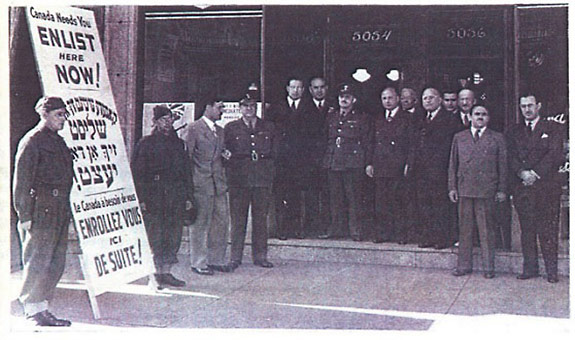
In this picture, we see a Jewish Canadian Recruitment Centre in Montreal. In what three languages is the sign written? What might the order of the languages suggest?
Jewish Canadian participation in the war
Read the following passage from Ellin Bessner’s Double Threat, then answer why you think so may Canadian Jews enlisted and served in the Second World War:
“[…] the nearly seventeen thousand Canadian Jews who donned a uniform in World War II came of age in a land where being Jewish meant facing antisemitism in personal and professional spheres. Some had been attacked by local gangs while swimming at Plage Laval, a popular summer spot north of Montreal, others while playing baseball at Toronto’s Christie Pits. They lived in a country where some companies would not hire Jews, where there were quotas limiting the number of Jews enrolled in some university faculties, and where Jews were restricted from joining some private clubs. Canada’s government was turning away thousands of Jewish refugees trying to outrun Europe’s repressive racial laws. Yet despite the government’s regrettable treatment of its Jewish citizens and refugees, many Canadian Jewish men rushed to the recruiting centres when the war broke out.”
Bessner, Ellin. Double Threat: Canadian Jews, the Military, and World War II. Toronto: University of Toronto Press, 2019: xv.
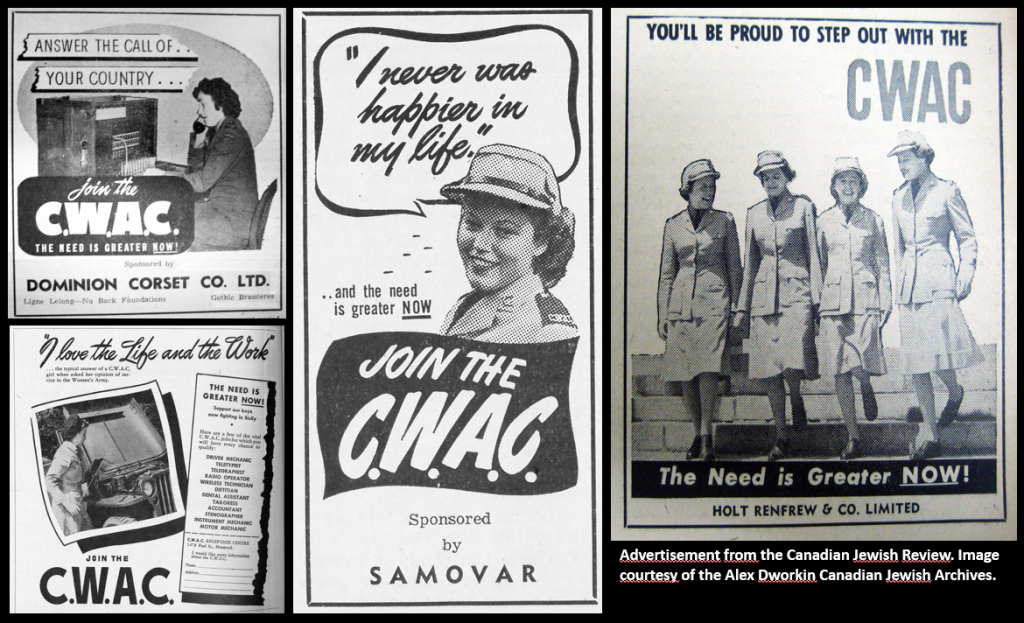
The Second World War drew thousands of Jewish men and 279 Jewish women into Canada’s armed forces -Gerald Tulchinsky
Tulchinsky Gerald, Canada’s Jews: A People’s Journey (Toronto: University of Toronto Press, 2008), 376.
Corporal Mimi Freedman

Mimi Freedman was born in Montreal but lived in England when the war broke out. To help with the war effort, Mimi joined the London Ambulance Service in 1939. In 1943, she joined the Canadian Women’s Army Corps (CWAC). The CWAC was created in 1941 to allow women to join the Army. Mimi served in administrative duties while she was stationed in England, France, Belgium, and Germany. She also served as an interpreter as she spoke French, Dutch, Flemish, and German. As David Rome notes in Canadian Jews in World War II, Mimi was the ‘‘only Jewish servicewoman to be decorated in the Second World War’’ (69). Mimi served for almost seven years.
To learn more about the contributions of the Canadian Jewish women during the Second World War, click here to read Saundra Lipton’s article, ‘‘She Also Served: Bringing to Light the Contributions of the Canadian Jewish Servicewomen of the Second World War.’’
Corporal Josef Eisinger
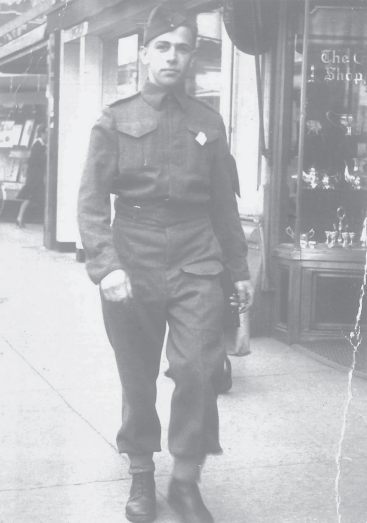
I do recall how proudly I wore my Canadian Army uniform as I walked down Yonge Street shortly after I was inducted [into the Canadian army]—and was snapped by a sidewalk photographer. -Josef Eisinger
Eisinger, Josef . Flight And Refuge: Reminiscences of a Motley Youth. (New York: self-published, 2016), 100.
Oral History: Josef Eisinger
In this oral history, Josef explains how his status as an enemy alien affected his path in the Canadian army.
Wayne and Shuster
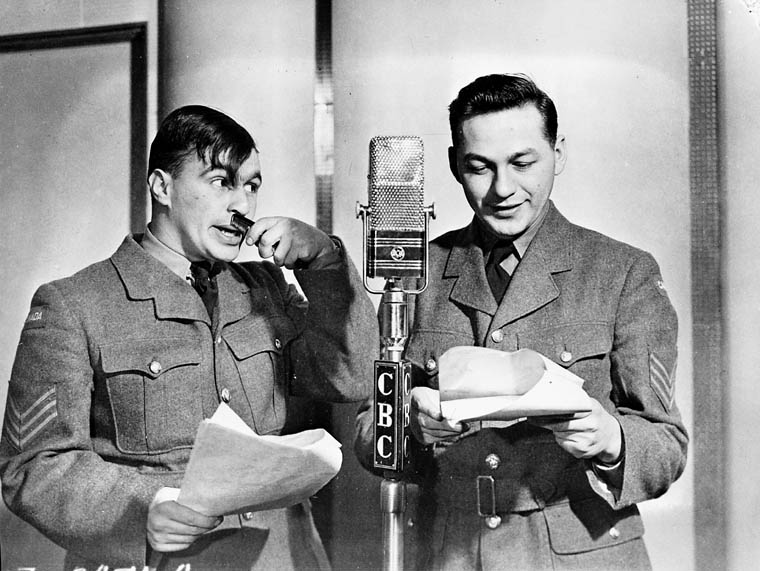
In 1942, Torontonians John Louis Wayne and Frank Shuster enlisted in the Canadian military in the midst of the Second World War and shortly thereafter were featured on The Canadian Army Show, a popular comedy radio show. Due to their popularity, the sergeant comedy duo was eventually sent overseas as part of The Army Show that performed across Canada, England and continental Europe to entertain Allied troops.
The Wayne and Shuster Show
This video commemorates the 50th anniversary of the Wayne and Shuster Show. It was hosted in 2005 by Frank Shuster and includes a segment (13:45 to 15:57) in which he recounts their debut as a duo in 1941 and plays a tape of one of their sketches on The Canadian Army Show.
Frank Shuster. Wayne & Shuster – 50 Years Of Comedy. 2005. CBC.
Liberation of Bergen-Belsen
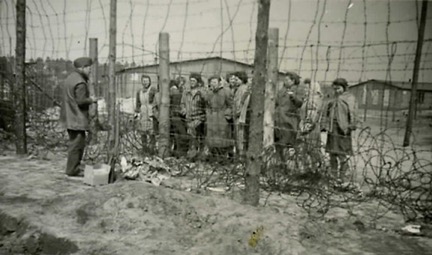
On April 15, 1945, British forces liberated about 60,000 prisoners at the Bergen-Belsen concentration camp located in northern Germany. Upon its establishment in 1943, the camp was used for prisoners of war, but it gradually transitioned into a concentration camp for Jewish prisoners.
In the above picture, how is it possible that the soldier was talking with prisoners at Bergen-Belsen? What language might they have had in common? How was this possible? What do you think they talked about?
Behind the Swastika: Nazi Atrocities
In 1945, the National Film Board of Canada produced “Behind the Swastika: Nazi Atrocities,” which is a film about the horrors discovered at Bergen-Belsen. Click on the link below to watch the film and consider the following questions: In what ways might the film have accurately or inaccurately portrayed the discoveries made at the camp? How does the documentary treat the Holocaust? Why?
Please note that this film contains scenes of violence that are particularly difficult and explicit.
https://www.nfb.ca/film/behind_the_swastika_nazi_atrocities/
Canadian War Heroes Comic Books
In the following images, we see a comic book that tells the tales of Jewish heroism in the Canadian Armed Forces. Who do you think these comic books were created for? What purpose did they serve?
To navigate this interactive book, click “read” and then select the volume you would like to read. Once you are in one of the three volumes, click on the page number below the image of the page on the black slider. Feel free to read all three volumes by selecting a new one in the table of contents.

